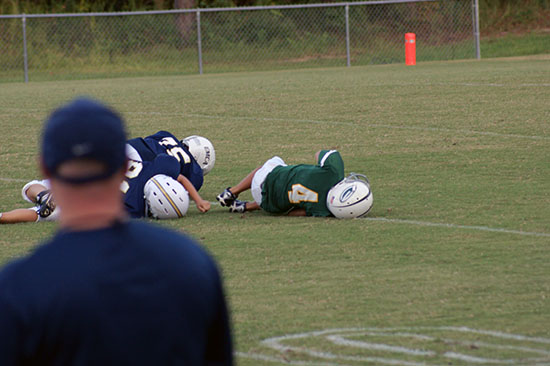Could Pee-Wee Football Lead to Brain Injury?
MED study: more brain damage in NFL players who started playing early

Last January, HBO’s Real Sports host Bryant Gumbel interviewed former NFL coach and player Mike Ditka. One of the things Gumbel asked Ditka was, if he had an eight-year-old son now, would he allow him to play football. “Nope,” Ditka said. “That’s sad. I wouldn’t, and my whole life was football. I think the risk is worse than the reward.”
Ditka was referring to recent studies showing that former professional football players who suffered repetitive head trauma during their careers were developing chronic traumatic encephalopathy (CTE), a neurodegenerative disease that can cause dementia, memory loss, aggression, and depression.
Now a new study by a team of researchers from the BU School of Medicine and Brigham and Women’s Hospital confirms Ditka’s reservations. The study, published online in the Journal of Neurotrauma in July, found that former NFL players who started playing tackle football before the age of 12 had a higher risk of altered brain development compared to those who started the sport when they were older.
The study, funded by the National Institutes of Health (NIH), is the first to show a link between early exposure to repetitive head impacts and structural brain changes later in life, the researchers said.
The corresponding author on the study, Robert Stern, a MED professor of neurology, neurosurgery, and anatomy and neurobiology and director of the Clinical Core of the BU Alzheimer’s Disease Center, cautions that the findings “are not necessarily indicative of chronic traumatic encephalopathy,” a disease that can currently be diagnosed only by autopsy.
“While this study adds to the growing concern that exposing children to repetitive hits to the head in tackle football may have long-lasting consequences,” Stern says, “there are likely other contributing factors that contribute to overall risk for CTE.”
The study is part of BU’s Diagnosing and Evaluating Traumatic Encephalopathy Using Clinical Tests (DETECT) project, which works to develop methods of diagnosing CTE during a patient’s lifetime.
The researchers tested 40 former NFL players (none of whom were identified) between the ages of 40 and 65 who had spent more than 12 years playing organized football, with at least 2 years playing in the NFL. Half of the players started playing tackle football before the age of 12, and the other half after they turned 12. The number of concussions was similar between the two groups, and all of the players had experienced memory and thinking problems for at least six months.
The study used an advanced type of MRI (magnetic resonance imaging) on the former players that specifically looked at the movement of water molecules along the brain’s white matter tracts. These tracts are the superhighways within the brain that relay commands and information. The researchers found that the players who started to play tackle football before age 12 were more likely to have changes of the white matter tracts of the corpus callosum, which connects the two halves, or hemispheres, of the brain.
The research team points to growing evidence of a “critical window” of brain development for children between the ages of 10 and 12, when the brain may be especially susceptible to injury.
“This development process may be disrupted by repeated head impacts in childhood possibly leading to lasting changes in brain structure,” explains lead author Julie Stamm (MED’15), a postdoctoral fellow at the University of Wisconsin School of Medicine and Public Health, who conducted the study as part of her MED doctoral dissertation.
The authors stress that the study, with just 40 athletes, was a small one, and they say that the results cannot be generalized to include those who began to play tackle football before the age of 12, but did not go on to play professional football. Rather than proving a cause-and-effect relationship, the study demonstrates the “association between younger age of first exposure to tackle football and abnormal brain imaging patterns later in life,” says study senior author Martha Shenton, director of Harvard Medical School’s Psychiatry Neuroimaging Laboratory.
Previous research by the research team published in January found that former NFL players who started playing tackle football before age 12 were at a higher risk of developing mood, behavioral, or cognitive impairment later in life than those who took up the game after age 12.
In both studies, the authors say more investigation is needed into later-life consequences of childhood exposure to repetitive head impacts. Their ultimate goal, they stress, is to increase safety in youth sports and to help young athletes compete without putting their health at risk. Professional athletes in other sports, such as hockey, wrestling, boxing, and baseball, have also been found to have CTE.
Parents appear to be taking note. The number of kids ages 6 to 12 playing football fell 29 percent, to 1.3 million, from 2008 to 2013, according to the Sports & Fitness Industry Association.
This BU Today story was written by .